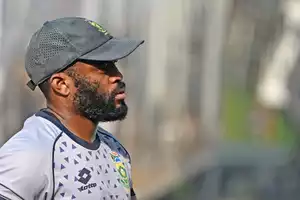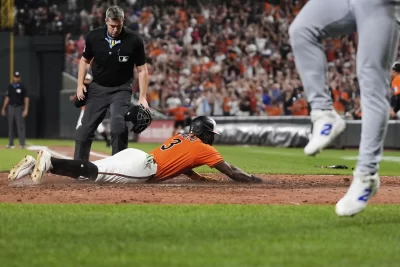
Elvis Presley killed JFK, and now runs a hotel with Jim Morrison in Morocco, from where the Illuminati, the Freemasons and Bill Gates rule the world with the help of a powerful global cabal, who cooked up Covid-19 to seize control of everything forever. And Temba Bavuma is undroppable because he is black.
All of the above conspiracy theories, and others, are available in a social media cesspool near you. The last of them, fuelled by racism, has been particularly in vogue during the men’s World Cup in India. So, Rob Walter was asked on Tuesday, was Bavuma subject to the pressure all players are under to keep their places?
“Absolutely he is,” Walter said. “Temba hasn’t come into the conversation about being dropped because he has been one of our best batters for the entire year. From my point of view, he hasn’t scored the runs he would have wanted to in the World Cup. But in every training he looks like he’s close, and in every game he looks like he’s close. A good score from him is just round the corner. As far as being undroppable, no-one’s bigger than the team. The same goes for Temba.”
Bavuma was South Africa’s highest runscorer in ODIs in 2023 leading into the World Cup – 637 at an average of 79.62, also the highest, and a strike rate of 104.08, seventh on that list. At the tournament he has made 145 runs – fewer than six of his teammates – in seven innings. Eight of South Africa’s players average higher than his 20.71, and 11 have a better strike rate than his 75.12.
What the haters won’t want highlighted is that those numbers put Bavuma, who is in line to lead his team in the final in Ahmedabad on Sunday if South Africa get past Australia in their semifinal at Eden Gardens on Thursday, in excellent company.
Eoin Morgan was fifth among England’s runscorers and sixth in the averages and the strike rates in 2019. In 2015 Michael Clarke was fifth, seventh and fifth by the same measures. MS Dhoni came in at sixth, fourth and ninth in 2011. Ricky Ponting led Australia to two World Cup triumphs, but he had a better tournament than all of his Aussie peers just once and in one sense only: in 2003 when he topped the runscoring charts with 415 in 10 innings. Yet calls for their heads during those tournaments weren’t heard – maybe because, like Bavuma, they were worth their weight in leadership.
How many times in all the dozen World Cups yet played has the captain of the winning team led his side in all three of those metrics? Once, in 1983, when none of India’s other players could match the 303 runs Kapil Dev scored at 60.60 and a strike rate of 108.99.
The only other leading performances by the captains of World Cup champion teams in any of the three categories are Clive Lloyd’s strike rate of 104.63 and 81.45 in 1975 and 1979, Arjuna Ranatunga’s average of 120.50 in 1996, Steve Waugh’s run aggregate of 398 in 1999, and Ricky Ponting’s run aggregate of 415 in 2003. The leaders of the winning teams have come out ahead in just 13.89% of the key batting departments.
Besides currently, the anti-Bavuma brigade were at their noisiest after the T20 World Cup in Australia in November, when he captained the side who crashed out of the running for the knockouts in an ignominious loss to the Netherlands. Bavuma scored 70 runs in five innings at a strike rate of 112.90 in that tournament, and Cricbuzz has learnt that he survived the selectorial axe on a three-person panel by one vote. Being the captain and black thus did not protect him from coming under the scrutiny applied to other players.
The decision to retain Bavuma at the T20 World Cup was unfair on Reeza Hendricks, who rode the bench throughout despite going to the tournament having scored from 53 to 74 in four of his previous five innings in the format. Bavuma resigned the leadership in February and has played in just three of South Africa’s half-dozen T20Is this year, and then probably only because Quinton de Kock, Heinrich Klaasen and David Miller were rested for a series against Australia in August.
The clamour for Hendricks to replace Bavuma is rising again. And especially in light of Hendricks making 85 off 75 when he stepped in at short notice after Bavuma withdrew, because of a stomach problem, from the game against England at the Wankhede on October 21.
But the strong case Hendricks had for playing at the T20 World Cup is not neatly transferred to this tournament. He appeared in only three ODIs this year before coming to India, scoring 52, 29 and 28 for an average of 39.66 and a strike rate of 85.00. Three days after his enterprising innings against England he was clean-bowled for 12 by Shoriful Islam, also in Mumbai. So the argument for Hendricks being preferred to Bavuma is significantly less compelling than it was last year.
Typical of the sad logic of Bavuma’s more irrational detractors is their widely expressed hope that he will not play in Thursday’s semifinal because of the hamstring strain he suffered while fielding against Afghanistan in Ahmedabad on Friday. But their wish would have been rocked by Bavuma coming through a training session at Eden Gardens on Monday in one piece.
“Yesterday was a step in the process of declaring him fit,” Walter, himself a fitness expert in a previous life in cricket, said. “We didn’t do any high-speed running, we didn’t do any fielding, we didn’t do any running between wickets. You would still have to factor those into the preparation, and check him out in the more high-speed zones.
“That’s how the progression happens. You go from when the injury happens to the rehab that has happened over the last 72 hours. Each day brings something new to test whether he is ready and match fit. We ticked a box yesterday. Today there will be a few more boxes to be ticked.”
Bavuma seemed to get one of them out of the way when, shortly after the South Africans arrived for their training session at Eden Gardens on Tuesday evening, he walked towards the netting that had been erected around the pitch table to keep it safe from practising players.
The light fence met Bavuma at chest height, but he was able to step over it easily enough and continue his journey to the middle to have a look at the surface being prepared for Thursday’s game. He strode with purpose, looking like someone who had a point to prove, a match to play, a World Cup semifinal to help win.







